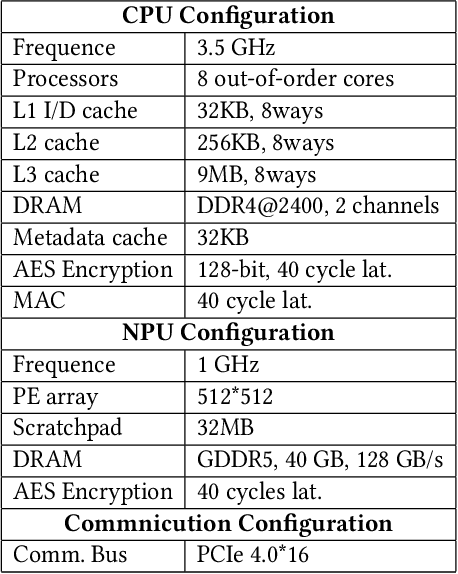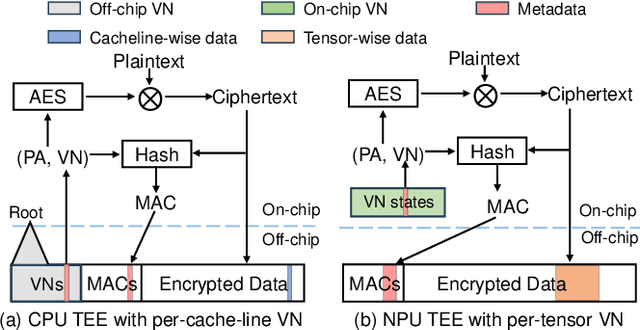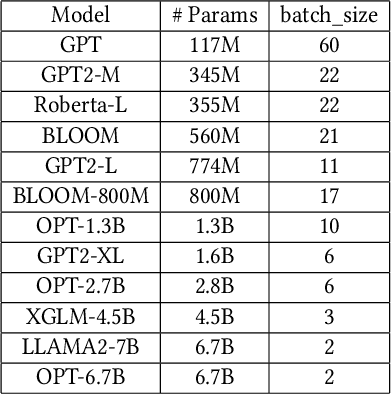Yuanbo Wen
QiMeng-Attention: SOTA Attention Operator is generated by SOTA Attention Algorithm
Jun 14, 2025Abstract:The attention operator remains a critical performance bottleneck in large language models (LLMs), particularly for long-context scenarios. While FlashAttention is the most widely used and effective GPU-aware acceleration algorithm, it must require time-consuming and hardware-specific manual implementation, limiting adaptability across GPU architectures. Existing LLMs have shown a lot of promise in code generation tasks, but struggle to generate high-performance attention code. The key challenge is it cannot comprehend the complex data flow and computation process of the attention operator and utilize low-level primitive to exploit GPU performance. To address the above challenge, we propose an LLM-friendly Thinking Language (LLM-TL) to help LLMs decouple the generation of high-level optimization logic and low-level implementation on GPU, and enhance LLMs' understanding of attention operator. Along with a 2-stage reasoning workflow, TL-Code generation and translation, the LLMs can automatically generate FlashAttention implementation on diverse GPUs, establishing a self-optimizing paradigm for generating high-performance attention operators in attention-centric algorithms. Verified on A100, RTX8000, and T4 GPUs, the performance of our methods significantly outshines that of vanilla LLMs, achieving a speed-up of up to 35.16x. Besides, our method not only surpasses human-optimized libraries (cuDNN and official library) in most scenarios but also extends support to unsupported hardware and data types, reducing development time from months to minutes compared with human experts.
Mutual-Supervised Learning for Sequential-to-Parallel Code Translation
Jun 11, 2025Abstract:The rise of GPU-based high-performance computing (HPC) has driven the widespread adoption of parallel programming models such as CUDA. Yet, the inherent complexity of parallel programming creates a demand for the automated sequential-to-parallel approaches. However, data scarcity poses a significant challenge for machine learning-based sequential-to-parallel code translation. Although recent back-translation methods show promise, they still fail to ensure functional equivalence in the translated code. In this paper, we propose a novel Mutual-Supervised Learning (MSL) framework for sequential-to-parallel code translation to address the functional equivalence issue. MSL consists of two models, a Translator and a Tester. Through an iterative loop consisting of Co-verify and Co-evolve steps, the Translator and the Tester mutually generate data for each other and improve collectively. The Tester generates unit tests to verify and filter functionally equivalent translated code, thereby evolving the Translator, while the Translator generates translated code as augmented input to evolve the Tester. Experimental results demonstrate that MuSL significantly enhances the performance of the base model: when applied to Qwen2.5-Coder, it not only improves Pass@1 by up to 28.91% and boosts Tester performance by 68.90%, but also outperforms the previous state-of-the-art method CodeRosetta by 1.56 and 6.92 in BLEU and CodeBLEU scores, while achieving performance comparable to DeepSeek-R1 and GPT-4.1. Our code is available at https://github.com/kcxain/musl.
QiMeng: Fully Automated Hardware and Software Design for Processor Chip
Jun 05, 2025



Abstract:Processor chip design technology serves as a key frontier driving breakthroughs in computer science and related fields. With the rapid advancement of information technology, conventional design paradigms face three major challenges: the physical constraints of fabrication technologies, the escalating demands for design resources, and the increasing diversity of ecosystems. Automated processor chip design has emerged as a transformative solution to address these challenges. While recent breakthroughs in Artificial Intelligence (AI), particularly Large Language Models (LLMs) techniques, have opened new possibilities for fully automated processor chip design, substantial challenges remain in establishing domain-specific LLMs for processor chip design. In this paper, we propose QiMeng, a novel system for fully automated hardware and software design of processor chips. QiMeng comprises three hierarchical layers. In the bottom-layer, we construct a domain-specific Large Processor Chip Model (LPCM) that introduces novel designs in architecture, training, and inference, to address key challenges such as knowledge representation gap, data scarcity, correctness assurance, and enormous solution space. In the middle-layer, leveraging the LPCM's knowledge representation and inference capabilities, we develop the Hardware Design Agent and the Software Design Agent to automate the design of hardware and software for processor chips. Currently, several components of QiMeng have been completed and successfully applied in various top-layer applications, demonstrating significant advantages and providing a feasible solution for efficient, fully automated hardware/software design of processor chips. Future research will focus on integrating all components and performing iterative top-down and bottom-up design processes to establish a comprehensive QiMeng system.
QiMeng-TensorOp: Automatically Generating High-Performance Tensor Operators with Hardware Primitives
May 08, 2025Abstract:Computation-intensive tensor operators constitute over 90\% of the computations in Large Language Models (LLMs) and Deep Neural Networks.Automatically and efficiently generating high-performance tensor operators with hardware primitives is crucial for diverse and ever-evolving hardware architectures like RISC-V, ARM, and GPUs, as manually optimized implementation takes at least months and lacks portability.LLMs excel at generating high-level language codes, but they struggle to fully comprehend hardware characteristics and produce high-performance tensor operators. We introduce a tensor-operator auto-generation framework with a one-line user prompt (QiMeng-TensorOp), which enables LLMs to automatically exploit hardware characteristics to generate tensor operators with hardware primitives, and tune parameters for optimal performance across diverse hardware. Experimental results on various hardware platforms, SOTA LLMs, and typical tensor operators demonstrate that QiMeng-TensorOp effectively unleashes the computing capability of various hardware platforms, and automatically generates tensor operators of superior performance. Compared with vanilla LLMs, QiMeng-TensorOp achieves up to $1291 \times$ performance improvement. Even compared with human experts, QiMeng-TensorOp could reach $251 \%$ of OpenBLAS on RISC-V CPUs, and $124 \%$ of cuBLAS on NVIDIA GPUs. Additionally, QiMeng-TensorOp also significantly reduces development costs by $200 \times$ compared with human experts.
QiMeng-Xpiler: Transcompiling Tensor Programs for Deep Learning Systems with a Neural-Symbolic Approach
May 04, 2025Abstract:Heterogeneous deep learning systems (DLS) such as GPUs and ASICs have been widely deployed in industrial data centers, which requires to develop multiple low-level tensor programs for different platforms. An attractive solution to relieve the programming burden is to transcompile the legacy code of one platform to others. However, current transcompilation techniques struggle with either tremendous manual efforts or functional incorrectness, rendering "Write Once, Run Anywhere" of tensor programs an open question. We propose a novel transcompiler, i.e., QiMeng-Xpiler, for automatically translating tensor programs across DLS via both large language models (LLMs) and symbolic program synthesis, i.e., neural-symbolic synthesis. The key insight is leveraging the powerful code generation ability of LLM to make costly search-based symbolic synthesis computationally tractable. Concretely, we propose multiple LLM-assisted compilation passes via pre-defined meta-prompts for program transformation. During each program transformation, efficient symbolic program synthesis is employed to repair incorrect code snippets with a limited scale. To attain high performance, we propose a hierarchical auto-tuning approach to systematically explore both the parameters and sequences of transformation passes. Experiments on 4 DLS with distinct programming interfaces, i.e., Intel DL Boost with VNNI, NVIDIA GPU with CUDA, AMD MI with HIP, and Cambricon MLU with BANG, demonstrate that QiMeng-Xpiler correctly translates different tensor programs at the accuracy of 95% on average, and the performance of translated programs achieves up to 2.0x over vendor-provided manually-optimized libraries. As a result, the programming productivity of DLS is improved by up to 96.0x via transcompiling legacy tensor programs.
MigGPT: Harnessing Large Language Models for Automated Migration of Out-of-Tree Linux Kernel Patches Across Versions
Apr 13, 2025Abstract:Out-of-tree kernel patches are essential for adapting the Linux kernel to new hardware or enabling specific functionalities. Maintaining and updating these patches across different kernel versions demands significant effort from experienced engineers. Large language models (LLMs) have shown remarkable progress across various domains, suggesting their potential for automating out-of-tree kernel patch migration. However, our findings reveal that LLMs, while promising, struggle with incomplete code context understanding and inaccurate migration point identification. In this work, we propose MigGPT, a framework that employs a novel code fingerprint structure to retain code snippet information and incorporates three meticulously designed modules to improve the migration accuracy and efficiency of out-of-tree kernel patches. Furthermore, we establish a robust benchmark using real-world out-of-tree kernel patch projects to evaluate LLM capabilities. Evaluations show that MigGPT significantly outperforms the direct application of vanilla LLMs, achieving an average completion rate of 72.59% (50.74% improvement) for migration tasks.
All-in-one Weather-degraded Image Restoration via Adaptive Degradation-aware Self-prompting Model
Nov 12, 2024



Abstract:Existing approaches for all-in-one weather-degraded image restoration suffer from inefficiencies in leveraging degradation-aware priors, resulting in sub-optimal performance in adapting to different weather conditions. To this end, we develop an adaptive degradation-aware self-prompting model (ADSM) for all-in-one weather-degraded image restoration. Specifically, our model employs the contrastive language-image pre-training model (CLIP) to facilitate the training of our proposed latent prompt generators (LPGs), which represent three types of latent prompts to characterize the degradation type, degradation property and image caption. Moreover, we integrate the acquired degradation-aware prompts into the time embedding of diffusion model to improve degradation perception. Meanwhile, we employ the latent caption prompt to guide the reverse sampling process using the cross-attention mechanism, thereby guiding the accurate image reconstruction. Furthermore, to accelerate the reverse sampling procedure of diffusion model and address the limitations of frequency perception, we introduce a wavelet-oriented noise estimating network (WNE-Net). Extensive experiments conducted on eight publicly available datasets demonstrate the effectiveness of our proposed approach in both task-specific and all-in-one applications.
Unpaired Photo-realistic Image Deraining with Energy-informed Diffusion Model
Jul 24, 2024Abstract:Existing unpaired image deraining approaches face challenges in accurately capture the distinguishing characteristics between the rainy and clean domains, resulting in residual degradation and color distortion within the reconstructed images. To this end, we propose an energy-informed diffusion model for unpaired photo-realistic image deraining (UPID-EDM). Initially, we delve into the intricate visual-language priors embedded within the contrastive language-image pre-training model (CLIP), and demonstrate that the CLIP priors aid in the discrimination of rainy and clean images. Furthermore, we introduce a dual-consistent energy function (DEF) that retains the rain-irrelevant characteristics while eliminating the rain-relevant features. This energy function is trained by the non-corresponding rainy and clean images. In addition, we employ the rain-relevance discarding energy function (RDEF) and the rain-irrelevance preserving energy function (RPEF) to direct the reverse sampling procedure of a pre-trained diffusion model, effectively removing the rain streaks while preserving the image contents. Extensive experiments demonstrate that our energy-informed model surpasses the existing unpaired learning approaches in terms of both supervised and no-reference metrics.
TensorTEE: Unifying Heterogeneous TEE Granularity for Efficient Secure Collaborative Tensor Computing
Jul 12, 2024



Abstract:Heterogeneous collaborative computing with NPU and CPU has received widespread attention due to its substantial performance benefits. To ensure data confidentiality and integrity during computing, Trusted Execution Environments (TEE) is considered a promising solution because of its comparatively lower overhead. However, existing heterogeneous TEE designs are inefficient for collaborative computing due to fine and different memory granularities between CPU and NPU. 1) The cacheline granularity of CPU TEE intensifies memory pressure due to its extra memory access, and 2) the cacheline granularity MAC of NPU escalates the pressure on the limited memory storage. 3) Data transfer across heterogeneous enclaves relies on the transit of non-secure regions, resulting in cumbersome re-encryption and scheduling. To address these issues, we propose TensorTEE, a unified tensor-granularity heterogeneous TEE for efficient secure collaborative tensor computing. First, we virtually support tensor granularity in CPU TEE to eliminate the off-chip metadata access by detecting and maintaining tensor structures on-chip. Second, we propose tensor-granularity MAC management with predictive execution to avoid computational stalls while eliminating off-chip MAC storage and access. Moreover, based on the unified granularity, we enable direct data transfer without re-encryption and scheduling dilemmas. Our evaluation is built on enhanced Gem5 and a cycle-accurate NPU simulator. The results show that TensorTEE improves the performance of Large Language Model (LLM) training workloads by 4.0x compared to existing work and incurs only 2.1% overhead compared to non-secure training, offering a practical security assurance for LLM training.
Prompt-based Visual Alignment for Zero-shot Policy Transfer
Jun 05, 2024



Abstract:Overfitting in RL has become one of the main obstacles to applications in reinforcement learning(RL). Existing methods do not provide explicit semantic constrain for the feature extractor, hindering the agent from learning a unified cross-domain representation and resulting in performance degradation on unseen domains. Besides, abundant data from multiple domains are needed. To address these issues, in this work, we propose prompt-based visual alignment (PVA), a robust framework to mitigate the detrimental domain bias in the image for zero-shot policy transfer. Inspired that Visual-Language Model (VLM) can serve as a bridge to connect both text space and image space, we leverage the semantic information contained in a text sequence as an explicit constraint to train a visual aligner. Thus, the visual aligner can map images from multiple domains to a unified domain and achieve good generalization performance. To better depict semantic information, prompt tuning is applied to learn a sequence of learnable tokens. With explicit constraints of semantic information, PVA can learn unified cross-domain representation under limited access to cross-domain data and achieves great zero-shot generalization ability in unseen domains. We verify PVA on a vision-based autonomous driving task with CARLA simulator. Experiments show that the agent generalizes well on unseen domains under limited access to multi-domain data.
 Add to Chrome
Add to Chrome Add to Firefox
Add to Firefox Add to Edge
Add to Edge